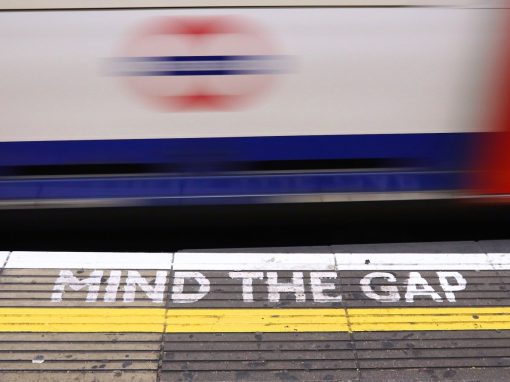A recent UKIPO Decision, between Transport for London and high street fashion retailer, GAP, regarding the renowned London Underground catchphrase “MIND THE GAP” has highlighted the importance of ensuring that prior agreements are adhered to when filing new trade mark applications.
Background
In 2021, Transport for London (TfL) applied to register “MIND THE GAP” as a UK trade mark. The phrase is long associated with the London Underground and is used as a warning for passengers to be cautious when boarding and alighting from the trains. The mark was applied for with the following goods:
Class 9: Contact lenses; spectacles, eyeglasses, eyewear and their frames, cases, chains, and lenses; helmets.
Class 18: Goods made of leather and imitations of leather, namely, shoulder belts and shoulder straps, suitcases, trunks, garment bags for travel, briefcases, card cases, canes, umbrellas and parasol covers; beach bags; sports bags; shopping bags and wheeled shopping bags; rucksacks; school bags; school satchels; portfolios; brief cases; document bags and cases; music cases; attaché cases; travel bags; trunks and travelling bags; suitcases; slings and pouches for carrying infants; hat boxes; key cases; purses and wallets; purses for travel cards and passes; purses for payment cards; wallets for travel cards and passes; wallets for payment cards; holders for payment cards, travel cards and travel passes; cases for toiletry or cosmetic articles; umbrellas, parasols and walking sticks; clothing for pets
UK high street clothing retailer, GAP, filed an opposition against this application on a number of grounds as set out below:-
- 3(6) – That the mark had been filed in bad faith
- 5(2) – That TfL’s mark is similar to their earlier marks for “GAP” which covered similar or identical goods
- 5(3) – That their earlier marks have a reputation for which TfL’s application takes unfair advantage of
- 5(4)(a) and (b) – That the mark would be passing off on GAP’s earlier registrations.
GAP based their opposition on a number of their earlier registrations all being of the word mark “GAP” and covering goods such as sunglasses and cases, bags, bandoliers, helmets, clothing, footwear and headgear.
GAP’s predominant argument consisted of the bad faith allegation under S. 3(6) of the Trade Marks Act. This allegation was put forward due to the existence of a confidential agreement between the two parties, dating back to 2004, which restricted TfL from filing trade marks for “MIND THE GAP”, in relation to clothing and clothing accessories.
GAP alleged that the “MIND THE GAP” application breached this agreement.
In their defence, TfL disagreed with GAP, as they claimed that the goods in the application were “eyewear, bags and luggage” and not clothing accessories, and therefore the agreement was still standing.
Additionally, TfL argued that the mark has been used consistently for many years in the London Underground with the general public associating the catchphrase “MIND THE GAP” with the London Underground for many years. They also noted that the mark was not similar to GAPs marks, nor that any passing off had occurred.
UKIPO ruling
Regarding the similarity of the goods, the Hearing Officer found that the bag-related goods in class 18 were identical to those in GAPs earlier marks.
However, they affirmed that the rest of the goods were not similar as headgear was not the same as protective headgear, i.e. helmets, belts for clothing in class 25 were not the same as shoulder belts in class 18, belts for bags have a different purpose to clothing belts, clothing and money belts are not the same as wallets and purses, though they could be considered competitive goods and that hats are not the same as hat boxes.
When comparing the marks, the Hearing Officer found that as MIND THE GAP was made up of three words, and GAP was only one word, there was very little similarity between the marks.
Additionally, the Hearing Officer found it unlikely that the average consumer would dissect the mark into “MIND THE” and “GAP”. They also found that GAP was not the dominant element in TfL’s application, and as the average consumer perceives the mark as a whole, particularly when the words form a warning, and that there would be no likelihood of direct confusion between the marks.
Regarding the further grounds, the Hearing Officer did not find TfL to be passing off GAP’s earlier marks, as there was no misrepresentation to the public on TfL’s side. They also noted that whilst GAP is a well-known brand in the UK for clothing, footwear and headgear, as there was no likelihood of confusion between the marks, the opposition grounds on Section 5(3) did not succeed.
Finally, regarding the allegation of bad faith relating to the mark being filed despite the prior agreement prohibiting TfL from filing applications for clothing and accessories, the Hearing Officer found that the following goods were in breach of the agreement, and the following were subsequently removed from the specification:
Purses and wallets, including purses for travel cards and passes, purses for payment cards; wallets for travel cards and passes, and wallets for payment cards; card cases and holders for cards and passes
The rest of the goods were maintained and “MIND THE GAP” proceeded to registration with the following goods: –
Class 9: Contact lenses; spectacles, eyeglasses, eyewear and their frames, cases, chains, and lenses; helmets.
Class 18: Goods made of leather and imitations of leather, namely, shoulder belts and shoulder straps, suitcases, trunks, garment bags for travel, briefcases, card cases, canes, umbrellas and parasol covers; beach bags; sports bags; shopping bags and wheeled shopping bags; rucksacks; school bags; school satchels; portfolios; brief cases; document bags and cases; music cases; attaché cases; travel bags; trunks and travelling bags; suitcases; slings and pouches for carrying infants; hat boxes; key cases; cases for toiletry or cosmetic articles; umbrellas, parasols and walking sticks; clothing for pets.
Conclusion
This case highlights both the risks involved in signing and honouring agreements and the increasing potential for allegations of bad faith coming up in trade mark hearings. However, it also shows the power a distinctive trade mark with renowned reputation can have in achieving registration in overcoming litigious proceedings.









